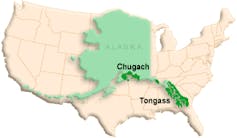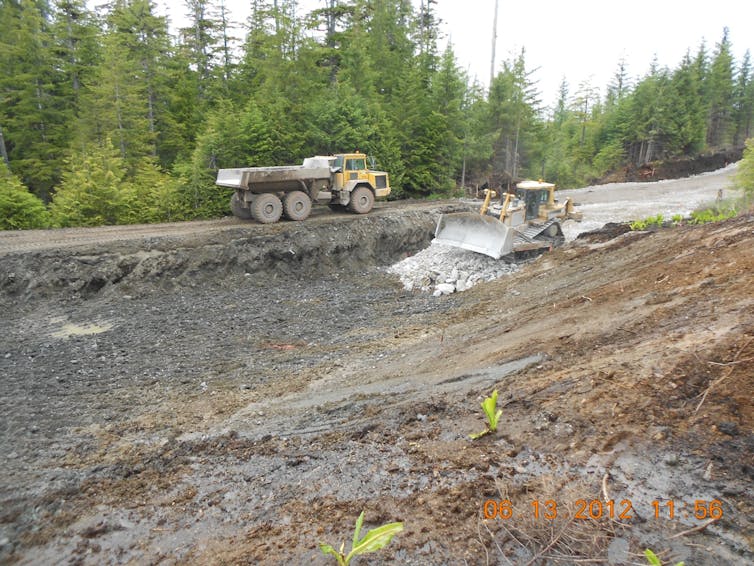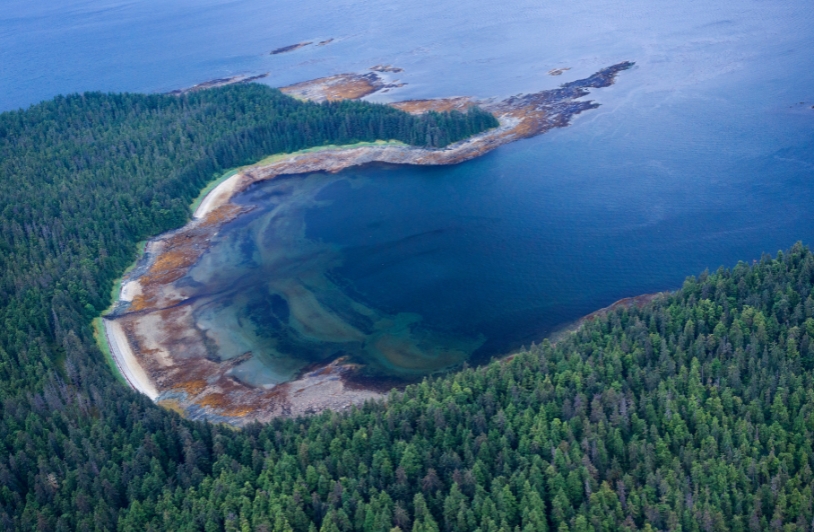Over 9 Million Acres To Be Protected, Keeping Them Free From Road-building and Logging
Ask people to find the world’s rainforests on a globe, and most will probably point to South America. But North America has rainforests too – and like their tropical counterparts, these temperate rainforests are ecological treasures.
The Biden administration finalized a rule on Jan. 25, 2023, that restores roadless protection to more than 9 million acres of the Tongass National Forest, keeping this land free from road-building and logging. The Tongass is the largest intact temperate rainforest in the world and the biggest U.S. national forest. It spreads over more than 26,000 square miles (67,340 square kilometers) – roughly the size of West Virginia – and covers most of southeast Alaska. It has thousands of watersheds and fjords, and more than a thousand forested islands.

USFS
For over 20 years, the Tongass has been at the center of political battles over two key conservation issues: old-growth logging and designating large forest zones as roadless areas to prevent development. As a scientist specializing in forest ecosystems, I see protecting the Tongass as the kind of bold action that’s needed to address climate change and biodiversity loss.
An ecological gem
The Tongass as we know it today began forming at the end of the Little Ice Age in the mid-1700s, which left much of what is now southern Alaska as barren land. Gradually, the area repopulated with plants and animals to become a swath of diverse, rich old-growth forests. President Theodore Roosevelt designated the Tongass as a forest reserve in 1902, and then as a national forest in 1907.
The Tongass is the traditional homeland of the Tlingit, Haida and Tsimshian people. It is named for the Tongass group of the Tlingit people, who have continuously occupied the area for over 10,000 years.
Alaska Natives relied on the forest’s rich diversity of plants and animals for their survival and traditions. Today the Tongass has abundant populations of animals that have become uncommon in other parts of the U.S., such as brown bears and wolves.
Most of the 900 watersheds within the Tongass are in near-natural condition. This ensures that they can provide habitat for many wild species and recover from or adapt to stresses, such as warmer temperatures due to climate change. They support salmon that spawn in the forest’s creeks and rivers, providing food for bears, eagles and other predators. Such ecosystems are incredibly rare around the world today.
How roads threaten forests
Intact old-growth forests, with trees hundreds of years old, are essential for carbon storage, biodiversity and climate resilience. They have fully developed root systems that can reach water in deep soils, and are more resistant than young forests to drought, fire, insects and strong winds – effects that are all likely to increase with climate change.
 Because old-growth forests have accumulated massive amounts of carbon in their trees and soils over centuries, protecting them is an important strategy for curbing climate change. Today, however, scientists estimate that logging, agriculture and urban development have left only 6% to 14% of the forest area in the U.S. intact. And only 7% of total U.S. forest area is more than a century old.
Because old-growth forests have accumulated massive amounts of carbon in their trees and soils over centuries, protecting them is an important strategy for curbing climate change. Today, however, scientists estimate that logging, agriculture and urban development have left only 6% to 14% of the forest area in the U.S. intact. And only 7% of total U.S. forest area is more than a century old.
Old-growth logging is controversial because intact forests are so rare. And forest losses often start when roads are cut through them to access timber. The roads are effectively long clear-cuts across the landscape.
Building roads through moist temperate forests can make it easier for warm air, wind and sunlight to penetrate from the edges to the interior, drying soil, mosses and ferns. It also provides entry points for invasive plants carried in by vehicles.
And roads’ negative effects extend beyond the actual driving surface. A road 30 feet (9 meters) wide may influence an additional 80 to 100 feet (25 to 30 meters) of adjacent land because of land disturbance during construction and wide buffer zones created for vehicle safety.
Road building can harm animals like brown bears through collisions with vehicles and increased poaching and trapping. In the Tongass, a strip a quarter-mile (0.4 kilometer) wide on each side of the highway system is closed to big game hunting, but this mitigates only some of roads’ pervasive effects.

Jack Olen, USFS Alaska Region/Flickr, CC BY
Decades of controversy
The controversy over roadless areas began in January 2001, when the Clinton administration adopted the Roadless Area Conservation Rule. This measure barred logging, timber sales, mining and road construction within inventoried roadless areas in most national forests across the U.S. About 9.2 million acres (37,231 square kilometers) of the Tongass – more than half of its area – were designated and managed as inventoried roadless areas.
This step launched 20 years of debate and litigation. The Bush and Trump administrations, supported by conservative Western state officials, sought to limit the roadless rule and exempt the Tongass from it. The Obama administration generally supported the rule and defended it in court.
In 2020, the Trump administration opened the Tongass to extensive new logging, mining and road construction activities. Critics, including environmental advocates and tribal governments, argued that Alaska’s economy was better served by outdoor recreation and commercial fishing than by clear-cutting its remaining old-growth forests.
Now, the Biden administration has restored protection for roadless areas of the Tongass. President Joe Biden has also issued an executive order that calls for conserving mature and old-growth forests on federal land – although he has not yet banned logging in old-growth forests – and pledged to combat deforestation worldwide.
A strategic climate reserve
New protection for the Tongass comes amid growing alarm over two converging environmental crises: climate change and accelerated extinctions of plant and animal species. In my view, protecting ecological treasures like the Tongass is a critical way to address both issues at once, as scientists have recommended.
The southeastern and south-central regions of Alaska, which contain the Tongass and Chugach national forests, store about 1 billion metric tons of carbon in live and dead tree biomass. This amount could increase by 27% by 2100 if the forest is allowed to continue to grow and accumulate carbon.
I believe the Tongass’ vast intactness, rich biodiversity and significant carbon storage make it an excellent choice as the first of a series of strategic climate reserves – areas that scientists have proposed setting aside to protect large carbon sinks and biodiversity of plant and animal species. U.S. old-growth forests are disappearing rapidly, but with smart management they can deliver ecological benefits for decades to come.![]()
Beverly Law, Professor Emeritus of Global Change Biology and Terrestrial Systems Science, Oregon State University
This article is republished from The Conversation under a Creative Commons license. Read the original article.




